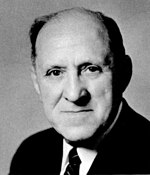Joseph Barnett

The belief that highways should be pleasing to the eye and compatible with the environment was a new idea when a foresighted engineer named Joseph Barnett joined the Bureau of Public Roads in 1933. By the time he retired 33 years later as Deputy Director for Engineering, Barnett had made good visual design a hallmark of American highways. His dedication to his work, his forceful pursuit of engineering principles and his extensive and lucid technical publications played a key role in the development of today’s highway policies. He was a pioneer in the standardization of geometric design—design of the visible features of a road; he advocated, long before it was fashionable, a balanced transportation system to eliminate urban traffic congestion; and he developed the principles of controlled access in modern highway construction.
Barnett was born January 1, 1897, on the lower east side of Manhattan and attended public schools. At the age of 16 he received a scholarship to Cooper Union Institute and graduated with a B.S. in civil engineering at 19. After serving a year as an ensign in the U.S. Navy, he worked for consulting firms in the field of structural design and building construction and with the city of New York in the area of city transit design.
In 1925 he went to work for the Westchester County Park Commission, taking part in the pioneering development of the first parkways and expressways in the New York metropolitan area. He moved from squad leader in structural design to chief of the Engineering Design Division. In these assignments he obtained unique experience in highway flowing alinement, parkway amenities, free traffic operation and controlled highway access which were to become the key features of Interstate highway design in years to come.
Barnett joined the Bureau of Public Roads (BPR) as Senior Highway Engineer, Division of Design, where his engineering experience was put to use in a series of special assignments. During the first 2 years, he directed the design of the George Washington Memorial Parkway on the Virginia side of the Potomac River from Memorial Bridge to Great Falls.
Barnett is remembered by his colleagues as having a tremendous sense of purpose and a terrific power of concentration. By the mid-1930’s he was applying himself to a new idea in highway construction—standardization of design.
He first brought order into the design of guardrail types then available and set standards for adequacy and use of the types subsequently developed. He then organized a countrywide study of speed-radius-superelevation on existing highway curves. Analysis of the data led to a new standard for superelevation design in relation to vehicle speed and the friction factors.
Knowing that better highway designs resulted from spiral or transition curves, Barnett worked out a set of practical spiral curve design tables that could be used by field survey engineers with calculations no more involved than those required for simple radii curves. His curve design manual, Transition Curves for Highways, was first published in 1938. It has been reprinted several times, translated into Spanish, recomputed to the metric system, and is still used extensively both here and abroad by highway design professionals.
Barnett was named Secretary of the Committee on Planning and Design Policies of the American Association of State Highway Officials (AASHO) from its inception in 1937 until his retirement at the end of 1966. This Committee profoundly influenced the design of safe and efficient highways. The scope of the series of AASHO standards, policies, and guides developed by the Committee attest to Barnett’s leadership and unique qualifications for the innovative development work. Collectively these writings showed his attributes in several forms: analyses of the subject item to derive major design principles; details
188
